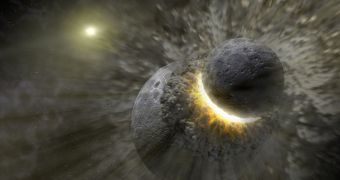An international collaboration of astronomers joined forces recently to gain a deeper understanding of a nearby star system, called beta Pictoris. The investigators were able to collect new, high-angular resolution photos of the giant extrasolar planet circling the stellar object.
The system is located an estimated 63.4 light-years away from Earth, but is considerably younger. While the Sun formed about 4.6 billion years ago, astronomers believe that our neighbor is only 12 million years old.
Though that may seem like a lot, it's actually the blink of an eye in astronomical terms. Despite its youth, the star has already grown to be 75 percent more massive than the Sun. But this also means that it will exhaust its hydrogen fuel reserves a lot faster.
One of the things that first attracted experts' attention to this particular system is the fact that it contains a massive, structured and extended protoplanetary disk. This is a large agglomeration of debris, that was left behind after the molecular cloud from which the star formed collapsed on itself.
Some theories suggest that the disk formed independent of the star, when planetoid-class objects that aggregated earlier began slamming into each other due to their crossing orbits.
According to records, beta Pictoris is the first star to have had its disk imaged. This happened well over 25 years ago. More than two decades later, observations revealed the existence of a massive exoplanet orbiting the star.
The giant object is located between 8 and 15 astronomical units away from its parent star. The protoplanetary disk makes it very difficult for experts to assess distances correctly from far away.
An astronomical unit, or AU, is the mean distance between the Earth and the Sun. It is equivalent to about 93 million miles, or 150 million kilometers. The object is called beta Pictoris b.
What makes this exoplanet special is that it's closest to its star to have ever been imaged directly. Other planets orbit their stars closer than that, but astronomers do not yet have access to the level of technology required to photograph these objects.
The recent investigations were conducted using the Very Large Telescope (VLT), a facility operated by the European Southern Observatory (ESO). The NAOS-CONICA instrument (NaCo) was also used.
Its name stands for Nasmyth Adaptive Optics System (NAOS) and COude Near Infrared Camera (CONICA). It is basically an advanced adaptive optics system, that enables the VLT to compensate for the flicker Earth's atmosphere causes in light coming in from outer space.

 14 DAY TRIAL //
14 DAY TRIAL //